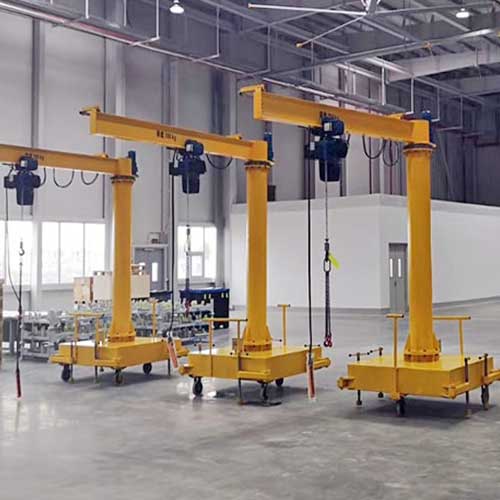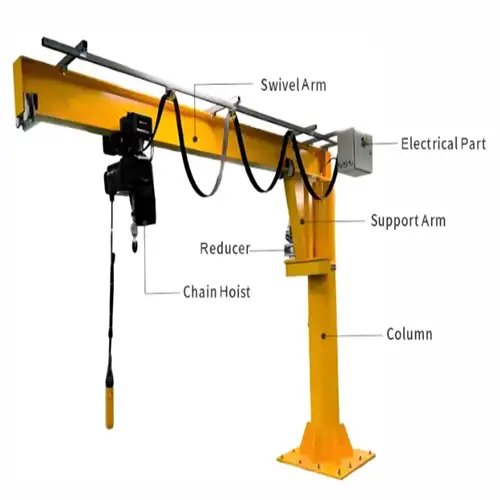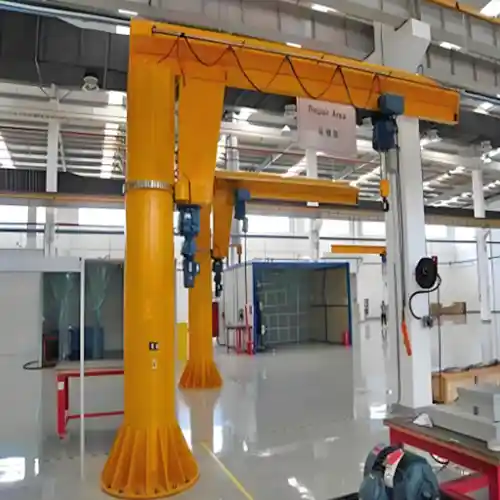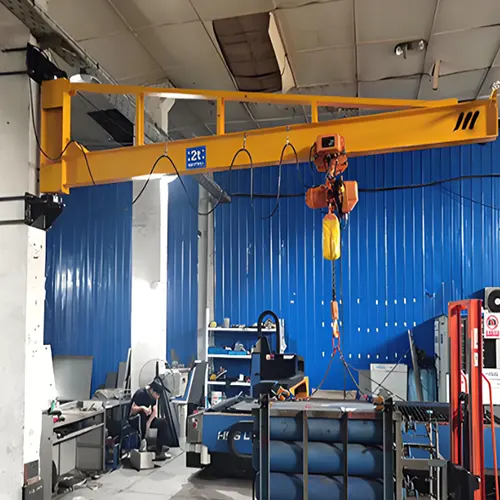Jib Crane on Wheels, Custom Portable Jib Crane on Wheels 250kg -2000kg
Jib crane on wheels overview. Portable jib cranes on wheels types, industrial applications, and users concerns & FAQS for your reference. Contact to get custom portable jib hoist now.
| Mobile Jib Crane Type | BZY |
| Lifting Capacity: | 0.25t / 0.5t / 1t / 2t |
| Lifting Height: | 1~3m / customized |
| Rotation radius: | Rotation radius: |
| Angle of rotation: | 270° / 360° |
| Rotary way: | manual / electric |
Category: Overhead Crane on Wheels
Your Trusted Jib Crane On Wheels Manufacturer & Supplier
Jib Crane on Wheels, Custom Portable Jib Crane on Wheels 250kg -2000kg
Jib crane on wheels overview. Portable jib cranes on wheels types, industrial applications, and users concerns & FAQS for your reference. Contact to get custom portable jib hoist now.
Exploring the World of Portable Jib Cranes
In the realm of material handling and heavy lifting, innovation has continually reshaped the landscape of efficiency and productivity. One such innovation that has earned its place in the spotlight is the portable jib crane on wheels. A marriage of mobility and might, these ingenious lifting solutions have become invaluable assets across a diverse range of industries.
Unlocking the Power of Mobility
Imagine a crane that can go where you need it, when you need it. That's the essence of a portable jib crane on wheels – a lifting marvel that combines the precision of a traditional jib crane with the flexibility of effortless mobility. In this comprehensive guide, we're embarking on a journey to explore the world of these versatile machines. Whether you're a seasoned crane user or considering one for your operations, join us as we unlock the power of mobility and delve into the intricacies of portable jib cranes.
Types of Portable Jib Cranes on Wheels
Jib cranes on wheels provide versatile lifting solutions with mobility, making them ideal for various industries and work environments. Two popular types are electric-powered portable jib cranes on wheels and battery-powered portable jib cranes on wheels.
- Electric-powered portable jib cranes use an external power source, offering consistent and strong lifting performance, ideal for indoor environments with easy access to electricity. They are often equipped with smooth motorized systems for easy movement and positioning.
- Battery-powered portable jib cranes, on the other hand, offer greater flexibility as they do not rely on external power. These cranes are perfect for outdoor or remote areas, providing mobility without the need for constant power supply. Their rechargeable batteries ensure prolonged use in areas where electricity is limited or unavailable.
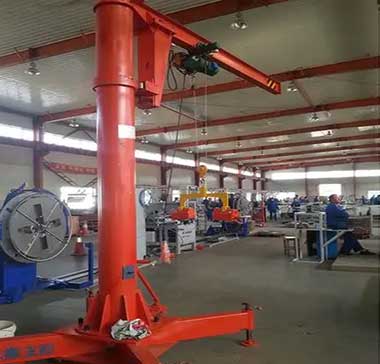
Manual Portable Jib Crane on Wheels
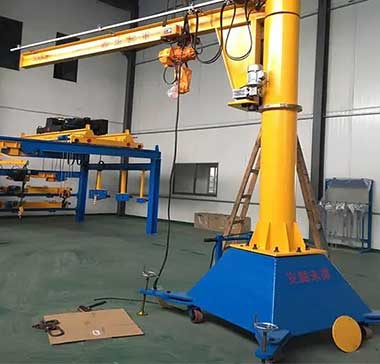
Electric Rotating Portable Jib Crane on Wheels
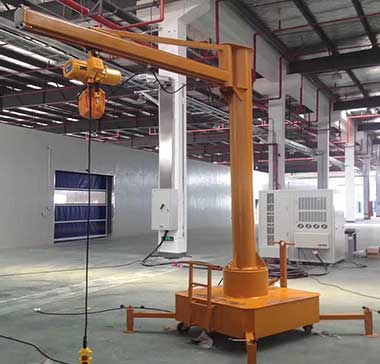
Fixed and Non-rotating Arm Portable Jib Crane on Wheels
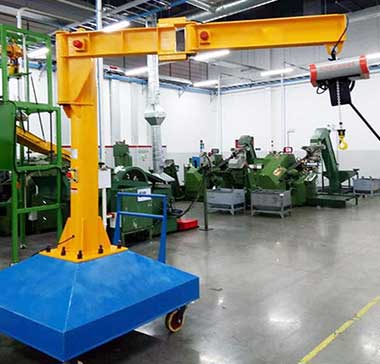
Articulating Arm Portable Jib Crane on Wheels
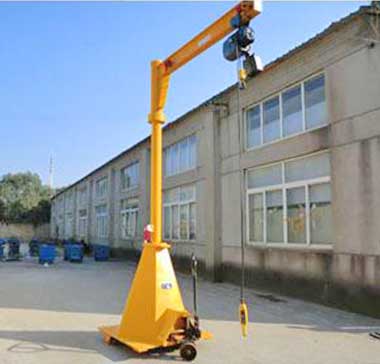
I Beam Portable Jib Crane on Wheels
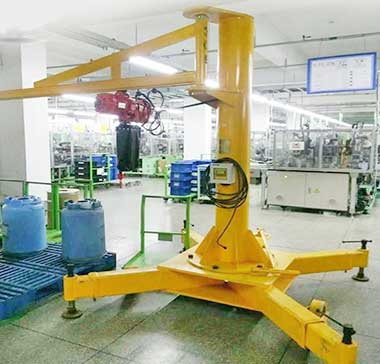
Tie Rod Portable Jib Crane on Wheels
Features, Benefits, and Typical Applications of Each Type
In this section, we'll take a closer look at the distinctive features, benefits, and typical applications of manual and electric portable jib cranes on wheels, helping you understand which type suits your needs best.
Manual Models
Features that Enhance Control and Precision
Manual portable jib cranes are known for their simplicity and the operator's direct control over the lifting process. Here are some features that enhance control and precision:
- Manual Control: The most distinctive feature of manual models is the hands-on control they provide. Whether through hand cranks or lever mechanisms, operators have direct control over lifting, lowering, and positioning, allowing for precise adjustments.
- Swivel Boom: Many manual jib cranes feature a swivel boom, which provides a wide range of motion. This allows operators to reach tight spots and access materials from various angles.
Benefits of Manual Models: When to Choose Them
Manual portable jib cranes offer unique advantages that make them the right choice in specific scenarios:
- Cost-Efficiency: Manual models are often more budget-friendly than their electric counterparts, making them an economical choice for smaller operations or occasional lifting needs.
- Precision Control: When tasks require careful maneuvering, such as assembly, welding, or positioning heavy equipment, manual cranes excel in providing the necessary control.
- Durability: These cranes are robust and durable, with fewer components that can malfunction, ensuring long-term reliability.
Typical Applications for Manual Models
Manual portable jib cranes find their niche in a variety of applications:
- Workshops and Maintenance: Ideal for workshops and maintenance areas, where precise control is essential for tasks like engine installation, welding, or equipment assembly.
- Manufacturing: Used on assembly lines for lifting and positioning components, aiding in efficient production processes.
- Loading and Unloading: Suitable for loading and unloading materials from trucks, especially in smaller facilities with limited space.
Electric Models
Power-Packed Features for Effortless Lifting
Electric portable jib cranes harness the power of electricity to streamline lifting operations. Here are some of the features that make them stand out:
- Powered Winch: Electric models come equipped with a powered winch or hoist, offering consistent and controlled lifting at the push of a button.
- Remote Control: Many electric jib cranes offer remote control options, allowing operators to stand at a safe distance while positioning loads with precision.
- Swivel and Rotation: Electric models often provide 360-degree rotation and swiveling capabilities, enhancing their versatility.
Advantages of Electric Models: Making Work Easier
Electric portable jib cranes provide several advantages that can significantly impact productivity:
- Efficiency: Electric cranes reduce manual effort, making lifting heavy loads more efficient and less physically demanding.
- Consistency: With precise controls and powered winches, electric cranes offer consistent and repeatable lifting performance.
- Versatility: Their mobility and ease of use make electric models versatile for a wide range of applications.
Typical Applications for Electric Models
Electric portable jib cranes excel in numerous industrial applications:
- Manufacturing: Used on assembly lines for lifting and positioning components with speed and accuracy.
- Warehousing: Efficiently move and stack heavy materials, improving warehouse logistics.
- Construction: Ideal for lifting construction materials and equipment on job sites, where ease of mobility is crucial.
In the next section, we'll explore typical industrial applications of portable jib cranes on wheels, shedding light on how these versatile machines serve various industries.
Typical Industrial Applications of Jib Cranes on Wheels
Bringing Lifting Solutions to Life Across Industries
Portable jib cranes on wheels are the unsung heroes of material handling, and their versatility knows no bounds. Let's take a journey through various industries and explore how these remarkable lifting solutions bring practicality, efficiency, and agility to a multitude of applications.
Showcasing the Versatility of Portable Jib Cranes
Manufacturing Industries
Portable jib cranes are like the conductors of an orchestra in manufacturing facilities. They effortlessly lift and position heavy components and machinery, optimizing production processes:
- - Assembly Lines: On assembly lines, jib cranes play a pivotal role in positioning parts and equipment for efficient assembly. They enhance precision and reduce manual labor, ultimately improving production rates.
- - Machine Shops: In machine shops, where precision is paramount, portable jib cranes aid in handling heavy workpieces, making tasks such as milling, drilling, and welding more manageable.
Warehousing and Distribution Centers
Warehouses are bustling hubs of activity, and portable jib cranes help keep things moving smoothly:
- - Material Handling: Jib cranes are used for loading and unloading heavy materials from trucks and containers, increasing the efficiency of logistics operations.
- - Order Picking: In distribution centers, cranes facilitate the retrieval of items from high shelves or pallets, ensuring rapid order fulfillment.
Construction Sites
The dynamic nature of construction sites demands equipment that can adapt to ever-changing needs:
- - Heavy Lifting: Portable jib cranes on wheels excel in lifting and positioning construction materials, tools, and equipment at various points within a construction site. Their mobility ensures they can be placed where they're needed most.
Maintenance and Repair
Maintenance professionals rely on the precision and control offered by jib cranes:
- - Vehicle Maintenance: In automotive garages and repair shops, cranes assist in lifting and maneuvering engines, transmissions, and other vehicle components during maintenance and repairs.
- - Facility Maintenance: For general facility maintenance tasks, such as HVAC system repairs or equipment servicing, portable jib cranes provide a safe and efficient solution.
Agriculture and Farming
Agriculture is not immune to the charms of portable jib cranes:
- - Livestock Handling: On farms, jib cranes help manage heavy equipment and materials used in livestock handling and agriculture-related tasks.
Outdoor Events and Entertainment
Even the world of entertainment benefits from the versatility of portable jib cranes:
- - Stage Setup: In the entertainment industry, cranes are employed for setting up stages and positioning equipment for concerts, festivals, and outdoor events.
Whether it's streamlining production lines in manufacturing, optimizing logistics in warehousing, or supporting construction endeavors, portable jib cranes on wheels are the dependable workhorses that adapt to diverse challenges. Their ability to be easily transported to various workstations makes them indispensable in countless industries. In the next section, we'll address the top concerns of users of jib cranes on wheels and provide answers to commonly asked questions to ensure your lifting operations are seamless and safe.
Top Concerns of Users of Jib Cranes on Wheels
In the world of portable jib cranes on wheels, safety, practicality, and maintenance are paramount. Let's address the top concerns that users often encounter and provide answers to ensure that your lifting operations are conducted smoothly and securely.
Safety First: Load Capacity Limits and Operator Training
Ensuring Safety Above All Else
Safety should always be the top priority when working with portable jib cranes. Here's what you need to know:
- Load Capacity Limits: Every jib crane has a specified load capacity limit. Exceeding this limit can result in accidents and damage to the crane. Always check the load capacity and ensure that the load being lifted falls within the safe range.
- Operator Training: Proper operator training is essential. Ensure that operators are well-trained and understand the crane's controls, load capacity limits, and safety procedures. Regular training and refresher courses can help maintain safe operations.
Answering Questions on Load Capacity and Training
- Q: How do I determine the load capacity of my jib crane?
A: The load capacity should be clearly indicated on the crane's documentation or label. It's crucial to refer to this information to ensure safe lifting operations. - Q: What kind of training do operators need?
A: Operators should receive comprehensive training that covers crane operation, load capacity limits, safety protocols, and emergency procedures. Training should be conducted by qualified personnel.
Practical Considerations: Overhead Clearance and Obstacle Awareness
Navigating the Workspace with Precision
Operating a portable jib crane in a busy workspace requires careful consideration of overhead clearance and obstacle awareness:
- Overhead Clearance: Always ensure there is adequate overhead clearance for the crane's movement. Avoid obstacles like lights, ductwork, and beams that may impede the crane's path.
- Obstacle Awareness: Operators should be vigilant and aware of their surroundings. Keep an eye out for obstacles that may come into contact with the crane's boom or load.
FAQs on Overhead Clearance and Obstacle Awareness
- Q: How much overhead clearance do I need for safe crane operation?
A: The required overhead clearance can vary based on the crane's specifications and the type of work being performed. Consult the crane's manual or a qualified expert to determine the exact clearance needed. - Q: What should I do if I encounter an obstacle while operating the crane?
A: Stop crane movement immediately and assess the situation. Safely lower the load if necessary and, if clearance is limited, reposition the crane to avoid the obstacle.
Maintenance Matters: Regular Inspections and Repairs
Keeping Your Crane in Prime Condition
Proper maintenance is essential for the longevity and safety of your jib crane:
- Regular Inspections: Perform routine inspections to check for wear and tear, loose bolts, and any signs of damage. Address issues promptly to prevent accidents.
- Scheduled Maintenance: Follow the manufacturer's recommended maintenance schedule. This may include lubrication, electrical checks, and component replacements as needed.
Addressing Common Maintenance Queries
- Q: How often should I inspect my jib crane?
A: Regular inspections should be conducted before each use, and a more comprehensive inspection should be performed at regular intervals as recommended by the manufacturer. - Q: Can I perform maintenance and repairs myself, or should I hire professionals?
A: While some maintenance tasks can be performed by trained operators, it's advisable to have a qualified technician or service provider handle more complex maintenance and repairs to ensure safety and compliance.
Addressing these concerns ensures that your portable jib crane on wheels operates safely, efficiently, and reliably. In the next section, we'll provide answers to frequently asked questions related to jib cranes on wheels, offering insights and solutions to common queries.
Cost Considerations
Cost is a significant factor when evaluating the feasibility and value of portable jib cranes on wheels for your lifting needs. In this section, we'll delve into various cost considerations, ranging from the initial purchase to ongoing operating costs, and ultimately, the return on investment (ROI) through a cost-benefit analysis.
Initial Purchase Costs
Investing in a portable jib crane is an important decision, and understanding the initial purchase costs is a critical first step in your decision-making process.
- Crane Model and Capacity: The specific model and load capacity of the crane you choose will significantly impact the initial purchase cost. Larger capacity cranes and more advanced models tend to have higher price tags.
- Features and Options: Additional features and options, such as powered winches, remote controls, and customizations, can increase the upfront cost. Consider which features are essential for your operations and budget accordingly.
- Brand and Manufacturer: Different brands and manufacturers may offer varying pricing for similar crane models. Research and compare options to find a reliable crane within your budget.
- Installation: Factor in the cost of installation, which may include the cost of a concrete foundation or any necessary structural modifications to support the crane.
Operating Costs
Beyond the initial purchase, operating costs play a crucial role in the long-term viability of your jib crane investment.
- Energy Consumption: Electric jib cranes will incur electricity costs during operation. Consider the energy efficiency of the crane and its impact on ongoing operating expenses.
- Maintenance and Repairs: Regular maintenance is essential to ensure safe and reliable crane operation. Budget for routine maintenance, inspections, and potential repair costs.
- Operator Training: Ongoing operator training and certification may be necessary. Plan for training expenses to ensure safe and competent crane operation.
- Consumables: Depending on your crane's design, you may need to budget for consumables such as lubricants, cables, and wear-and-tear parts.
ROI and Cost-Benefit Analysis
The true measure of a wise investment is the return on investment (ROI). Evaluating the cost-benefit ratio will help you determine if a portable jib crane on wheels is the right choice for your business.
- ROI Calculation: To calculate ROI, compare the total cost of ownership (initial purchase cost, operating costs, and any additional expenses) with the expected benefits, such as increased productivity, reduced labor costs, and improved safety.
- Cost-Benefit Analysis: A cost-benefit analysis involves quantifying the benefits of investing in a jib crane against the costs over a specific timeframe. This analysis can help you make an informed decision by considering factors like increased efficiency, reduced injury risks, and improved workflow.
- Long-Term Considerations: Keep in mind that the true value of a jib crane often extends beyond immediate financial gains. Improved safety, reduced downtime, and enhanced operational capabilities can provide long-term benefits that may not be immediately quantifiable.
By carefully assessing initial purchase costs, ongoing operating expenses, and conducting a thorough ROI and cost-benefit analysis, you can make a well-informed decision regarding the acquisition of a portable jib crane on wheels. This analysis will not only help you manage your budget effectively but also determine the long-term value and benefits it brings to your operations.
Popular Manufacturers and Brands
When it comes to choosing a portable jib crane on wheels, selecting a reputable manufacturer and brand is crucial. In this section, we'll provide an overview of some of the leading manufacturers in the industry and offer reviews and recommendations based on their track record and product quality.
Overview of Leading Manufacturers
In the competitive landscape of jib crane manufacturing, several companies have established themselves as industry leaders, known for their innovation and reliability. Here's an overview of some prominent manufacturers:
- Gorbel Inc.: Gorbel is a well-respected name in the material handling industry. They offer a range of jib crane solutions, including wall-mounted and freestanding models. Their products are known for their quality and durability.
- Columbus McKinnon: Columbus McKinnon is a global leader in lifting and material handling equipment. They provide a variety of jib crane options, and their cranes are widely recognized for their performance and safety features.
- Abell-Howe: Abell-Howe, with over a century of experience, is a trusted name in the jib crane market. They offer various jib crane configurations to suit different applications, from light-duty to heavy-duty.
- Gorbel Workstation Cranes: A division of Gorbel Inc., Gorbel Workstation Cranes specializes in ergonomic lifting solutions for workstations. They are known for their workstation jib cranes designed to improve workplace efficiency.
- Spanco: Spanco is known for its versatile jib crane designs and offers solutions for a wide range of industries, including manufacturing, aerospace, and construction.
- David Round: David Round specializes in custom-engineered jib cranes, making them an excellent choice for unique lifting needs. They are known for their attention to detail and tailor-made solutions.
Reviews and Recommendations
Choosing the right manufacturer and brand can significantly impact the performance and longevity of your portable jib crane. Here are some reviews and recommendations based on user experiences and industry feedback:
- Gorbel Inc.: Gorbel is often praised for the quality and durability of its products. Users appreciate the ease of installation and the versatility of their jib cranes. Their customer support and warranty options also receive positive feedback.
- Columbus McKinnon: Columbus McKinnon is recognized for its commitment to safety and innovation. Users often highlight the reliability and precision of their jib cranes. Their comprehensive range of options ensures there's a suitable crane for various applications.
- Abell-Howe: Abell-Howe's reputation for longevity and robustness is well-regarded. Customers who require heavy-duty jib cranes frequently choose their products. They are known for their excellent load capacity and durability.
- Gorbel Workstation Cranes: Gorbel Workstation Cranes receive praise for their ergonomic design and the positive impact they have on workplace efficiency. Users often mention the ease of use and the reduced risk of strain and injury.
- Spanco: Spanco is appreciated for its versatility and customization options. Users find their jib cranes suitable for various industries and applications. Spanco's commitment to safety also garners positive reviews.
- David Round: David Round's custom-engineered solutions are highly recommended for specialized lifting needs. Users appreciate their attention to detail and the ability to tailor jib cranes to specific requirements.
When selecting a manufacturer and brand, it's essential to consider your specific needs, budget, and the type of applications you'll be using the crane for. Reading user reviews and seeking recommendations from industry peers can help you make an informed choice that aligns with your lifting requirements.
Frequently Asked Questions (FAQs) on Jib Cranes on Wheels
Your Comprehensive Guide to All Things Portable Jib Cranes
Portable jib cranes on wheels offer a flexible solution for various lifting needs, but they often come with questions and concerns. Here, we provide answers to some of the most common FAQs to help you understand these versatile lifting machines better.
Q1: What is a portable jib crane on wheels, and how does it work?
A portable jib crane on wheels is a piece of material handling equipment designed for lifting and positioning heavy loads. It consists of a horizontal boom (or arm) that can rotate 360 degrees and a wheeled base for mobility. The crane can be manually operated or electrically powered, allowing it to lift and transport objects within its operational radius.
Q2: What are the advantages of using a portable jib crane on wheels?
Portable jib cranes offer several benefits, including:
- - Mobility: They can be easily moved to different workstations, providing flexibility in material handling.
- - Precise Positioning: Operators can precisely position loads, making them suitable for tasks that require accuracy.
- - Space Efficiency: They save floor space compared to traditional overhead cranes.
- - Ease of Use: Electric models offer user-friendly controls, while manual models provide hands-on control.
Q3: What are the typical load capacities of portable jib cranes on wheels?
Load capacities vary based on the crane's design and manufacturer. Light-duty models may have capacities as low as 500 pounds, while heavy-duty models can handle loads exceeding 5 tons. It's crucial to select a crane with a load capacity appropriate for your specific lifting needs.
Q4: How do I choose the right portable jib crane for my application?
Selecting the right crane involves considering factors such as load capacity, reach, mobility, and control type. Determine your lifting requirements and workspace constraints before consulting with a reputable crane supplier or manufacturer for guidance.
Q5: Are there safety considerations when using portable jib cranes on wheels?
Yes, safety is paramount when operating any crane. It's essential to:
Ensure operators are trained and certified.
Follow load capacity limits.
Be aware of overhead clearance and obstacles.
Conduct regular inspections and maintenance.
Implement proper safety procedures and protocols.
Q6: Can I use a portable jib crane outdoors?
Yes, you can use certain portable jib cranes outdoors. Battery-powered models are particularly suitable for outdoor use, as they don't require a fixed power source. However, ensure that the crane is designed and rated for outdoor conditions and consider factors like weather protection and terrain.
Q7: What are the differences between manual and electric portable jib cranes?
Manual cranes are operated by hand cranks or levers, offering precise control but requiring physical effort. Electric cranes use powered winches or battery-driven systems, providing easier lifting with the push of a button. The choice depends on the level of control and automation required.
Q8: Can portable jib cranes be used in confined spaces?
Portable jib cranes are versatile and can be adapted for use in confined spaces with appropriate planning. Choose a crane with a design that allows for maneuverability in tight areas and ensure that it meets safety and load capacity requirements.
Q9: What are the maintenance requirements for portable jib cranes on wheels?
Maintenance includes regular inspections, lubrication, and addressing wear and tear. Consult the manufacturer's guidelines and conduct routine checks to keep your crane in optimal condition.
Q10: What is the lifespan of a portable jib crane on wheels?
The lifespan of a crane depends on factors such as usage, maintenance, and environmental conditions. Well-maintained cranes can last for many years, providing a solid return on investment.
By addressing these frequently asked questions, we aim to provide you with a comprehensive understanding of portable jib cranes on wheels, helping you make informed decisions and operate these lifting solutions safely and efficiently. If you have additional questions or need specific guidance, don't hesitate to consult with crane experts or manufacturers.
Conclusion: Elevate Your Operations with Portable Jib Cranes
Summarizing the Key Takeaways
In this comprehensive guide, we've embarked on a journey through the world of portable jib cranes on wheels, unlocking the power of mobility and efficiency in material handling. Let's summarize the key takeaways and encourage informed decision-making:
Types of Portable Jib Cranes on Wheels
Manual models provide precise control, while electric models offer ease of use.
Hand-cranked, lever-operated, powered winches, and battery-powered models cater to diverse lifting needs.
Features, Benefits, and Typical Applications
Manual models excel in precise tasks like assembly and maintenance.
Electric models streamline heavy lifting, making them ideal for manufacturing and logistics.
Consider load capacity, controls, and mobility when choosing the right crane.
Typical Industrial Applications
Portable jib cranes are versatile and find applications in manufacturing, warehousing, construction, maintenance, agriculture, and entertainment.
They improve productivity, safety, and efficiency across various industries.
Top Concerns of Users
Prioritize safety by adhering to load capacity limits and providing operator training.
Be aware of overhead clearance and obstacles in your workspace.
Regular maintenance and inspections are essential for crane reliability.
Cost Considerations
Initial purchase costs vary based on crane type, features, and brand.
Operating costs encompass energy consumption, maintenance, and training.
Evaluate ROI and conduct a cost-benefit analysis to assess the long-term value.
Popular Manufacturers and Brands
Leading manufacturers like Gorbel, Columbus McKinnon, Abell-Howe, Spanco, Gorbel Workstation Cranes, and David Round offer quality jib cranes.
Reviews and recommendations help in selecting the right manufacturer for your specific needs.
Frequently Asked Questions (FAQs)
FAQs provide comprehensive insights into the world of portable jib cranes, addressing common queries about their functionality, safety, and applications.
In conclusion ,Portable jib cranes on wheels are not just lifting machines; they are catalysts for efficiency, safety, and productivity in various industries. By understanding the different types, features, and applications, and by addressing safety concerns, cost considerations, and manufacturer choices, you can elevate your operations to new heights.
We encourage you to use this knowledge as a valuable resource in making informed decisions about portable jib cranes, ensuring that your lifting operations are efficient, safe, and optimized for success. Whether you're enhancing your manufacturing process, streamlining warehouse logistics, or tackling construction challenges, portable jib cranes are poised to become your trusted partners in lifting excellence.
Related Products
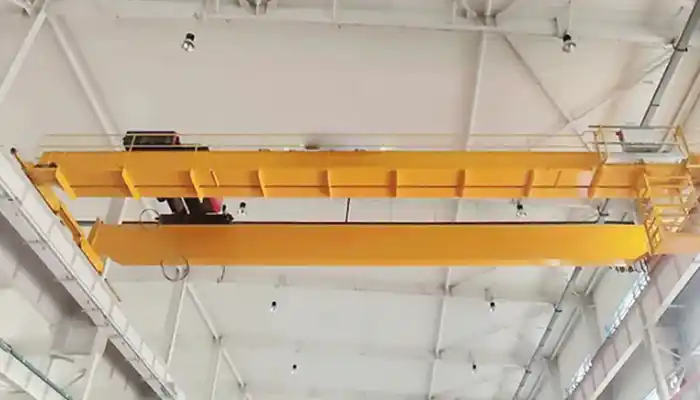
Latest project
Workshop Overhead Crane 5 Ton & 10 Ton Buying Guide
Practical guide for selecting, installing, and maintaining 5 ton to10 ton workshop overhead cranes for safe, efficient, and reliable material handling.
Free consultation to Confirm Parameters & Specifications and Get
Latest Crane Price & Crane Rate.
- Types of overhead cranes : _______?
- Optional: Overhead travelling crane, goliath gantry crane,Slewing jib crane, Single girder or double girder crane,small portable crane or kbk crane, etc.
- Capacity of overhead crane: _______?
- Optional: 0.25ton, 0.5 ton, 1 ton, 2 ton, 3ton, 5 ton, 10 ton,15ton, 20ton, 25 ton, 30ton,35ton, up to 550ton, etc.
- Crane span & lifting height : _______?
- Crane travelling length : _____?
- Control of overhead crane:_______?
- Optional: pendant/ remote/cabin control
- Voltage supply of overhead crane:_____?
- Eg,: 380V50/60HZ,3Phase or others,etc.
- Application/usage of crane:_______?
- Eg,: Steel mill, ,injection mold, cement,stone, concrete,granite, general manufacturing, etc.
Just leave a message via the contact form and our hoist and crane engineer will contact you with in 24working hours.
Get In Touch
